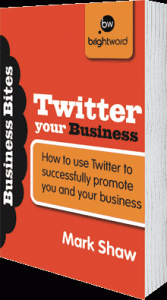Entries from April 2011 ↓
April 29th, 2011 — copywriting tips, social media, social media marketing, twitter
If you’re a business owner breaking into the world of Twitter you’ve probably set up your account, uploaded your avatar (using your photo), written your short bio and are now sitting in front of the screen scratching your head.
How do you go about using it as a business/social media platform?
Unless you want to land yourself the leading role in Spamalot don’t constantly bang on about business all the time.
Admittedly some of your offers will be useful to your followers but if you constantly tell people when you’re doing, how amazing your business is and what you’re selling they are going to get seriously cheesed off. The result will either be a lot of people hitting the unfollow button or a bunch of people that aren’t going to be interested in engaging with you.
So if you can’t use it for business bombardment what can you use it for?
Well, let’s get one thing straight, you can mention your business and tell people what you’re doing but just not all the time. Intersperse business tweets with personal reflections and comments. Twitter is all about building relationships and as such people need to get to know the real you. The only way that’s going to happen is by your personality shining through.
Have you gone pale at the thought of being ‘you’ online? That’s why I love Twitter so much. As a one-woman-band I think it’s really important that people get to know who I am. So my tweets usually consist of:
- Links to my latest blog posts
- Links to other things I found interesting
- Inane ramblings (there’s a lot of those)
- Copywriting/marketing tips
- Retweeting other people’s tweets
- Pleas for help
That last one highlights one of the major benefits of Twitter (certainly in my eyes). Since I’ve been tweeting I’ve had various IT issues and the such like which I’ve tweeted about only to have several knight’s in shining armour come to my rescue. And when you work alone that type if support is priceless.
 Of course it has also proven very beneficial to me in finding new clients too. You can read all about that in Mark Shaw’s fantastic Twitter Your Business book (click on the image to go and take a look at it). At just £10 it’s a great investment to make sure you get the most out of Twitter – and before you ask, no, I’m not on commission!
Of course it has also proven very beneficial to me in finding new clients too. You can read all about that in Mark Shaw’s fantastic Twitter Your Business book (click on the image to go and take a look at it). At just £10 it’s a great investment to make sure you get the most out of Twitter – and before you ask, no, I’m not on commission!
If you need some help getting going follow me @sallyormond and I’ll follow back and give any help I can.
Twitter is full of great people so take the plunge and come and join us – you might enjoy it.
April 27th, 2011 — copywriter, copywriting tips, internet marketing, website design
 If you’re starting up a business or looking to revamp your existing website, what will you go for – a custom build or a template?
If you’re starting up a business or looking to revamp your existing website, what will you go for – a custom build or a template?
For many of us cost is everything and a template design is undoubtedly cheaper. But is it always the best choice?
Yes you can download them and stick in your content and a few images and, hey presto, you’ve got yourself a web presence without forking out fees for a web designer (or copywriter). But web designers exist for some very good reasons:
- They understand the web
- They understand how it works
- Basically, they know what they’re doing.
Eric Brantner has written an interesting post on seohosting.com’s blog giving 5 Reasons Not To Use a Web Template. Although he does admit to having used them, Eric goes on to explain why they aren’t always a good idea.
1. You still have to be customised
Even though many of these templates are downloadable and ready to go, most of them are still going to have to be customised somehow to suit your design needs. Unless you happen to be a whiz at HTML coding you’re still going to need a web designer.
2. Not the best for branding
You brand has to be recognisable online. If you use a template, that’s going to be tough because you’re just going to like thousands of other sites out there.
It will be much better to get a custom design that will make your brand stand out.
3. Restricted zone
The template isn’t going to be easy to tweak, plus you’re probably going to be tied to licensing agreements with the template designer which will govern how you use the website. You will also probably have to have a link back to the designer’s own website somewhere.
4. You’re not alone
Hundreds, possibly thousands of people have downloaded the same template as you. Do you really want to be seen as a generic design rather than as someone with your own identity?
5. Bad news for SEO
Many templates aren’t designed with SEO in mind so getting the search engine spiders to crawl your site could be difficult, and as for ranking…if it can’t be crawled you’re not going to rank.
Eric’s tips are very valid and if you’re considering downloading a template design it’s well worth holding fire and reading through this list again.
If you’re serious about marketing your brand online you’re going to have to make a serious investment. Cutting corners now will not pay off.
April 25th, 2011 — Content marketing, copywriter, copywriting tips, online marketing, search engine optimisation, seo, SEO copywriter, seo website copywriter, small business web marketing, website copywriting
 Are you the type of person who breaks out into a cold sweat whenever you hear the term search engine optimisation?
Are you the type of person who breaks out into a cold sweat whenever you hear the term search engine optimisation?
To many it seems to be one of those mythical beasts that you can only tame if you’re armed to the teeth with an array of magical implements.
Well fear not for your knight(ess) in shining armour is here to save the day.
There are 5 very simple SEO checks you can make right now. Open up another browser window and pull up your website.
Ready?
OK, first things first. Let’s take a look at your website structure:
1. Looks aren’t everything
That’s something my mum was constantly telling me when I was growing up.
Take a look at your website – this one is especially pertinent for all owners of custom built websites. For many business owners the ‘look’ of their website is at the top of their list. It’s the part of the process that takes the biggest budget because they want theirs to be prettier than anyone else’s.
The problem with custom builds is that, sometimes, looks are at the expense of SEO, especially if you’ve been seduced by flash. Yes, it looks lovely but unless you’ve got some magic going on in the background coding it’s not going to help your search engine optimisation one jot.
Template websites – love them or loathe them – tend to be more SEO friendly from the start. If there are any web designers out there who want to disagree or comment further please do so, I’d love to hear your take on the design vs SEO debate.
Next we move on to how to get found in the first place, yup, the dreaded keyword research bit.
2. Keywords
Remember this post is all about simple SEO checks so I’m not going to delve into the realms of thorough keyword research.
Take a minute to jot down the top 3 words that you would use as a Google search to find your website.
For example I would choose copywriter, freelance copywriter and possibly Suffolk copywriter to get a geographical tag in there. Next ask a friend or colleague to do the same, in fact ask as many people as you like to do the same and eventually you’ll have a list of keywords.
You may not think that’s very scientific but it will give you keywords that real people would search under for you.
Next you do the hard bit and work out how competitive they are and which ones are the best to tackle (you’ll need to use something like Google’s free keyword research tool for this). The chart below should help you work that bit out.

It’s also a good idea, before you make any changes to your site, to search under the terms you decide on and write down your current ranking so you can watch in awe as your site rises ever higher.
That’s your keywords done, so what’s next? Well it’s back to your website.
3. All present?
If you want your site to rank for your identified keywords they need to be in your copy. That doesn’t mean cramming them into every sentence on the page. But rather weave them into the text in a couple of places.
Your headings and sub headings are always a good place to put them and in your title tags.
OK, so now you’ve got your words in your website copy, what’s next?
4. Power content
The next thing to do is write a page or blog post centred on your keywords (one for each keyword). Again that doesn’t mean stuffing, but using your keywords wisely (e.g. in a post of about 200-300 words, use your keyword 2 or 3 times).
Try and use it in your headings to give it more prominence. Once you’ve published these on your website you can then use them on your social media sites too (e.g. your Facebook page) and link back to your site using the keywords as your anchor text links.
With me so far? For the next bit you’ll need a bit of help.
5. Get votes
Every link that comes into your website acts like a vote of confidence in Google’s eyes. The more you have, the more authoritative you are.
So ask friends and colleagues to link to you (like a link exchange) using contextual anchor text links.
OK, so these 5 tips aren’t the most comprehensive SEO techniques but they can and will make a difference. So what have you go to lose? Give them a try and the come back and let me know how you get on.
April 22nd, 2011 — copywriter, copywriting tips, search engine optimisation, seo, SEO copywriter, seo website copywriter, website copywriter, website copywriting
 The world of search engine optimisation can be confusing.
The world of search engine optimisation can be confusing.
Identifying your keywords, looking at your site structure and building back links are all vital aspects if your SEO strategy is going to work.
But what can you do about your copy? Making sure it’s written by a professional SEO copywriter is obviously a step in the right direction but here’s a list of 8 quick tips you can use to optimise your web copy.
Open a second browser window and take a look at your web copy as you read – is there something you can improve?
1. Headline
As with any form of marketing, your headline must grab attention and draw your reader in. It must sell you, your company and your products and services.
A weak headline will result in people navigating away from your site to one that offers them what they’re looking for.
2. First impressions
Assuming your headline has caught their attention it’s vital that the rest of your website does. Do the first few lines of text live up to their expectations? Do the images you use compliment or detract from your copy?
To work, all the elements of your web page have to compliment each other and work together.
3. WIIFM?
This is the question that sits firmly in the forefront of your reader’s mind – what’s in it for me?
Make sure you tell them the benefits of your product/service straight away. That’s not the features here we’re talking about what it is that your product/service will do for them – save them time, save them money, make them more attractive, make them healthier etc. Something that they will value (that’s why it’s so important you know who your customers are and what they want).
4. Easy on the eye
This is where readability comes in. People don’t generally like reading from a screen so you must ensure your information is accessible and readable. To help you reader skim your content for the most relevant points use headings and sub headings, break the text up with bulleted lists and use images to help get your message across.
Above all keep Bryan Eisenberg’s 5 R’s of Search Engine Marketing in your mind:
- Relevance (make sure your copy is relevant to your market)
- Reputation (great content will build your reputation and encourage links)
- Remarkable (only truly great copy will build your reputation)
- Readability (use the right HTML, tags, headlines, bullets, sub headings, font size etc.)
- Reach (don’t cast your net too wide)
5. We
How many times does ‘we’ appear on your website?
A website full of ‘we’ comes across as being very self-centred. The reader doesn’t care about you; they care about what you’re going to do for them.
Go through your copy and change your ‘we’ for ‘you’ to shift the focus firmly on your customer.
6. Voice
The tone of voice you use is very important. The information you provide has to be accessible so avoid jargon. Also to make it more readable avoid using the passive voice. Be active and involve your reader in your text.
7. Other wording
The wording on your website isn’t just confined to your body text. There are also ALT tags, captions, banner text etc. Are the words here really adding value?
8. Hypertext
The hypertext links are the words you use to link out to other relevant information. Make sure you use your keywords within these links to get the most value from them.
That is a quick and simple list of things you can do on your website to help attract visitors and boost your conversion rate. How many are you missing on your website?
April 20th, 2011 — copywriting tips, internet marketing, marketing, online marketing
 The internet has revolutionised the way people shop and research.
The internet has revolutionised the way people shop and research.
Now practically any piece of information you need is at your fingertips. A quick Google search will find you local suppliers, research material and that obscure pram you have been searching for with an iPod dock.
However, as an online business are you making the most of those leads when they come to you?
Take a moment to imagine the person who has just completed your online form sitting at their computer. They have just hit the send button. Now what are they doing?
They are waiting – waiting for you to respond.
How quickly do you respond?
In a recent survey by Insidesales.com and Omniture the following, quite startling facts were unearthed:
- Average email response time: 19 hours, 31 minutes
*Optimum response time should be within the first hour
- Average phone response time: 36 hours, 57 minutes
*Optimum phone response time should be within the first five minutes
- How many companies even responded?
*Only 47.3 percent responded via email, and just 7.5 percent responded via phone!
That doesn’t make good reading.
The internet offers almost instant search results therefore internet users expect fast reaction times from companies on the internet. Recently I sent an email enquiry to a local business – it took them 2 weeks to respond and that’s not acceptable in anyone’s book.
So how can you make sure you are making the most of the leads that come to you through your website?
Here are 5 tips you can use to make your business more effective at making the most of your web enquiries.
1. Analytics
Analytics are the closest thing you’ll get to a crystal ball. They will show you where your traffic is coming from, what keywords are providing the most leads etc. Use this data to determine which sources provide you with the highest amount of converting traffic and ensure you do everything in your power to boost that source.
2. Lead forms
If you use a web based lead generation form (i.e. a form for your customers to complete when enquiring about your services), how effective is it?
If you’re asking a large number of questions you may be diluting the effectiveness of it. After all, how many people are going to want to sit for hours completing an online form?
Make sure the questions you ask are relevant and valuable – if any aren’t, ditch them.
3. Offer
Your website is nothing without an offer. But is that offer relevant and tempting?
If you find your leads are dipping, take a look at your offer. Try something new and compare results. Only through this constant testing can you define what it is that your customers see as a valuable offer.
4. Lead distribution
The chances are that within your company different people will be dealing with different leads. So how do you facilitate that at the moment? Are they printed off when someone has time and placed on desks? Do they eventually get forwarded on via email when someone has a moment?
As I’ve already said internet users want instant results. Use a system that automatically distributes the leads to the relevant people. That way they will receive a response instantly.
5. Be faster
Although left until last, this one is the most obvious. All you have to do to make your web leads more effective is respond to them quicker.
Even if that means sending an instant holding email that tells the person you’ll be in touch within 24 hours. Of course, if you do send a message like that make sure contact is made within the specified time.
If someone out there has taken the time to find your website, read what you have to say and complete your online form the least you can do is respond to them quickly. Do that and you’ll gain a great reputation and quality leads.
Sally Ormond – freelance copywriter
 Of course it has also proven very beneficial to me in finding new clients too. You can read all about that in Mark Shaw’s fantastic Twitter Your Business book (click on the image to go and take a look at it). At just £10 it’s a great investment to make sure you get the most out of Twitter – and before you ask, no, I’m not on commission!
Of course it has also proven very beneficial to me in finding new clients too. You can read all about that in Mark Shaw’s fantastic Twitter Your Business book (click on the image to go and take a look at it). At just £10 it’s a great investment to make sure you get the most out of Twitter – and before you ask, no, I’m not on commission! If you’re starting up a business or looking to revamp your existing website, what will you go for – a custom build or a template?
If you’re starting up a business or looking to revamp your existing website, what will you go for – a custom build or a template? Are you the type of person who breaks out into a cold sweat whenever you hear the term search engine optimisation?
Are you the type of person who breaks out into a cold sweat whenever you hear the term search engine optimisation? The world of search engine optimisation can be confusing.
The world of search engine optimisation can be confusing. The internet has revolutionised the way people shop and research.
The internet has revolutionised the way people shop and research.




